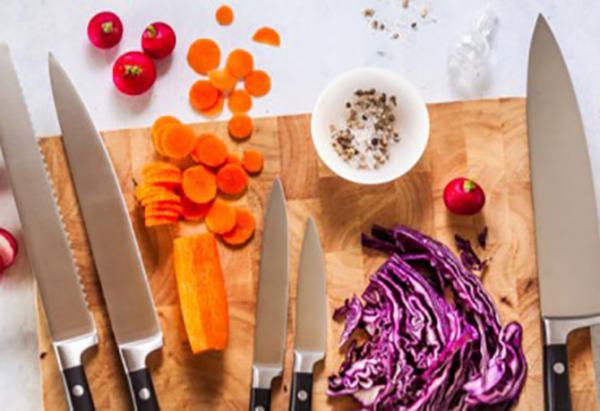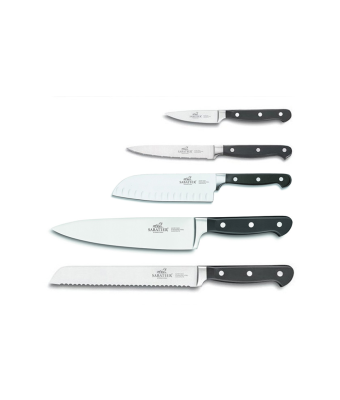Chef Recommended: 8 Essential Knives For Your Kitchen

Whether you're a world-class chef or simply a beginner in the kitchen, it always helps to have the basic tools to help you along the way. Whatever culinary creations you are conjuring up, good knives are essential to success - certainly if you are to become the chef you’re destined to be! So, when it comes to equipping your kitchen with the basics, what knives are a must-have?
In this guide:
- The Intro
- Bread Knife
- Paring Knife
- Cleaver
- Vegetable Knife
- Carving Knife
- Cheese Knife
- Fillet Knife
- Santoku Knife
Bread Knife
With a long, rectangular blade and a serrated edge, these knives are vital in the kitchen.
While you may not use your bread knife as much as other knives, when it comes to slicing a baguette or precisely cutting up a panini, you will understand how much easier a good bread knife makes it. In fact, when you need to slice up any bread, no other knife will do the trick.
Serrated bread knives are also great for cutting other foods. Believe it or not, they are perfect for cutting tomatoes. They can penetrate the skin and slice directly through the skin with little to no mess (unlike other knives). They are also great for use on thin-skinned knives such as peaches.
Using a sawing motion, the knife allows the teeth to grip and cut easily. Avoid using this knife for chopping and don’t use it to chop items such as small herbs or garlic.
Tip: When it comes to your bread knife, think beyond bread!
Paring Knife
With a smaller and sharp blade, your paring knife is your go-to tool for more delicate tasks such as peeling and trimming your fruits and vegetables.
Due to its small and compact size, it is easy to manipulate and makes tasks such as segmenting much simpler.
There are various types of paring knives for different jobs – from mincing and chopping, slicing and peeling. The one great factor that many chefs will praise this type of knife for is its fine attention to detail. With the knife blade being around 3 ½ inches long, it is amazing for the smaller job, ranging from mincing garlic, hulling strawberries or peeling vegetables.
Tip: Avoid using paring knives for harder vegetables such as carrots. The knife does not carry enough weight to carry out this task easily.
Cleaver
Also commonly known as a butchers knife, these knives are essential to anyone handling meat in their kitchen.
With a rectangular and heavy blade, this tool will break through, or ‘cleave’ meat and bone without any damage to your knife. The heftier blade will do the job that no other knife can – splitting, stripping and cutting any type of meat.
If you don’t have a high-quality butchers knife/cleaver and are preparing and serving meat in your kitchen, chances are you will not only spend countless extra hours on it, but you will also ruin your knives.
Tip: You can use a serrated knife to cut through certain meats such as pieces of steak, but when it comes to separating wings or cutting through a thick roast, nothing will compare to a trusty cleaver.
Vegetable Knife
Various tools can make your vegetable preparation much easier, and interesting! The knife for the vegetable prep is vital to help you chop, slice and dice all kinds of ingredients for soups stews or platters.
There are many different types of knife which are great for vegetables, with a particular favourite being a Nakiri knife. These Asian-style tools have a rectangular shape and will quickly slice through vegetables, producing almost paper-thin slices.
The blade of this knife is also perfect for moving your ingredients from the board to pan.
Tip: Keep all your vegetable knives and tools separate, alongside your chopping boards to avoid contamination.
Carving Knife
While quite similar to your serrated bread knife (chefs knife), this blade tends to longer and thinner, however, it is equally essential to any kitchen. It may be slightly less used, but it is still necessary.</>
Thanks to the extra-long and thinner blade, this knife is ideal for cutting thinner slices of meat, especially off large roasts. Everything from a roasted chicken to beef and even a nut roast can be carved delicately and precisely with a great carving knife. Sunday dinners will never be the same.
Tip: Slice, don’t saw and use the entire length of the blade with each stroke travelling in only one direction.
Cheese Knife
Any cheese-lover will understand the importance of a high-quality cheese knife. There are various types available (over 8!), which are made specifically for different types of cheeses.
p>The holes in the blade of the knife will stop the cheese from sticking and allow you to cut the perfect slices without the cheese squashing. Many cheese knives will also have a forked end to allow easy serving of your sliced cheese.
Whether you are preparing a cheese board or you simply fancy a slither of brie, these knives will be your lifesaver!
A soft cheese knife will be short, often with a curved blade and holes to reduce friction. A traditional hard cheese knife will resemble a small hatchet and will have a thick and almost straight blade.
Tip: For a wheel of cheese (in particular, Stilton) why not forget about knives altogether and opt for a scoop?
Fillet Knife
For anyone in the kitchen dealing with fish, a fillet knife is your best friend. The long, thin and slender blade usually has a point, which helps to separate the meat from the skin and delicately slice through to split into fillets.
Be sure to choose the right length for the kind of fish that you will be preparing the most. For trout and mackerel, a 16cm blade is suitable but for anything such as cod or salmon, you will most likely need a 20cm or more.
Tip: Alongside your fillet knife, a boning knife can be a great assistant. Used to remove bones from poultry, meat and fish, these are designed with precision in mind. The two knives can be used interchangeably in many cases.
Santoku Knife
The Santoku knife has its roots in Japan, actually meaning ‘three virtues’ – a fitting name for a versatile knife such as this. Unlike other knives, santokus have a round, cleaver-like tip and a granton edge (small dimples on edge of the blade) which helps prevent ingredients from sticking to the knife.
One of the great things about having a santoku knife in your essential collection is that it can be used for several kitchen tasks and also remain sharp for a long time on their own. They are essentially the Japanese version of a utility kitchen knife and can be used for anything from chopping to slicing, dicing and more.
Fact: The three-virtues, some say, relate to meat, fish and vegetables. Others interpret them to be chopping, slicing and dicing.
These are just a few of your everyday knives. Of course, depending on your speciality or everyday tasks, your essential knife list may differ. Building your collection is a process, and can be a lengthy one. It may take plenty of research to find out the best kit for you, and at Kitchen Knives, we’re here to help you.
Whether you are a professional chef or simply a passionate at-home chef, having suitable knives makes everything much easier, and fun! If you have any questions or would like further information, simply get in touch with our team who will be more than happy to help.

